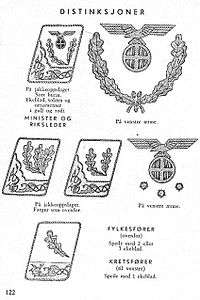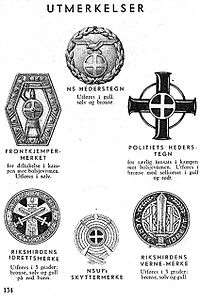Nasjonal Samling
Nasjonal Samling (Norwegian pronunciation: [nɑʂʊˈnɑːl ˈsɑ̀mlɪŋ], NS; literally "National Rally") was a Norwegian far-right party active from 1933 to 1945. It was the only legal party of Norway from 1942 to 1945. It was founded by former minister of defence Vidkun Quisling and a group of supporters such as Johan Bernhard Hjort – who led the party's paramilitary wing (Hirden) for a short time before leaving the party in 1937 after various internal conflicts. The party celebrated its founding on 17 May, Norway's national holiday, but was founded on 13 May 1933.
Nasjonal Samling | |
|---|---|
 | |
| Abbreviation | NS |
| Founder and leader | Vidkun Quisling |
| Secretary General | Rolf Jørgen Fuglesang |
| Founded | 13 May 1933 |
| Dissolved | 8 May 1945 |
| Headquarters | Oslo |
| Newspaper | Fritt Folk |
| Youth wing | NS Ungdomsfylking |
| Paramilitary wing | Hirden |
| Membership (1943) | 44,000 |
| Ideology | Fascism[1][2] Nazism[3][4] Fascist corporatism[5] Anti-communism Collaborationism |
| Political position | Far-right[6] |
| Religion | Lutheranism (official)[7] |
| Colours | Red and gold |
| Slogan | Heil og Sæl! ("Health and Happiness")[8] |
| Party flag | |
 | |
Pre-war politics
The party never gained direct political influence, but it made its mark on Norwegian politics nonetheless. Despite the fact that it never managed to get more than 2.5% of the vote and failed to elect even one candidate to the Storting, it became a factor by polarising the political scene.[9] The established parties in Norway viewed it as a Norwegian version of the German Nazis, and generally refused to cooperate with it in any way. Several of its marches and rallies before the war were either banned, or marred by violence when communists and socialists clashed with the Hird.
A significant trait of the party throughout its existence was a relatively high level of internal conflict. Antisemitism, anti-Masonry and differing views on religion, as well as the party's association with the Nazis and Germany, were hotly debated, and factioned the party. By the time the Second World War broke out, the party had been reduced to a political sect with hardly any real activity.
Strong belief in Norse Paganism, Romantic nationalism and totalitarianism dominated NS ideology. It also relied heavily on Nordic symbolism, using Vikings, pre-Christian religion and runes in its propaganda and speeches. It asserted that its symbol (shown at the head of this article), a golden sun cross on a red background (colours of the coat of arms of Norway), had been the symbol of St. Olaf, painted on his shield.[10]
During the German occupation
When Germany invaded Norway in April 1940, Quisling marched into the Norwegian Broadcasting Corporation studios in Oslo and made a radio broadcast proclaiming himself Prime Minister and ordering all anti-German resistance to end immediately. However, King Haakon VII, in unoccupied territory along with the legitimate government, let it be known he would abdicate rather than appoint any government headed by Quisling. The existing government refused to step down in Quisling's favour or serve under him, and confirmed that resistance was to be continued. With no popular support, the German forces of occupation quickly thrust Quisling aside. In April 1940 the party probably only had a few hundred members, but membership rose to 22,000 in December the same year, and peaked with 43,400 in November 1943.[11]
After a brief period with a civilian caretaker government (Administrasjonsrådet) appointed by the Supreme Court, the Germans took control through Reichskommissar Josef Terboven. He appointed a government responsible to himself, with most ministers from the ranks of Nasjonal Samling. However, the party leader, Quisling, was controversial in Norway as well as among the occupiers, and was denied a formal position until 1 February 1942, when he became "minister president" of the "national government". Other important ministers were Jonas Lie (also head of the Norwegian wing of the SS from 1941) as minister of police, Gulbrand Lunde as minister of "popular enlightenment and propaganda", and the opera singer Albert Viljam Hagelin, who was Minister of Home Affairs. The NS administration had a certain amount of autonomy in purely civilian matters, but it was in reality controlled by the Reichskommissar as "head of state", subordinate only to Adolf Hitler.
Post-war
The post-war authorities proscribed the party and prosecuted its members as collaborators. Nearly 50,000 were brought to trial, approximately half of whom received prison sentences. The authorities executed Quisling for treason as well as a few other high-profile NS members, and prominent German officials in Norway, for war crimes. The sentences' lawfulness has been questioned, however, as Norway did not have capital punishment in peace-time, and the Norwegian constitution at the time stipulated that capital punishment for war crimes had to be carried out during actual wartime.
Another issue of post-war treatment has been the ongoing Hamsun debate in Norway. The internationally renowned author Knut Hamsun, although never a member, was a well-known NS sympathiser.[12] After the war, Hamsun was, however, deemed mentally unfit to stand trial, and the issue of his links to the party has never been properly resolved. Hamsun's status as a Nobel Prize laureate and probably the best-known Norwegian author next to Henrik Ibsen also results in his ties to NS being a touchy subject, as many feel the valuation of Hamsun's literature should not be marred by constant debate about whether or not he was a fascist.
Uniforms and insignia
_Politisk_f%C3%B8rer.jpg)
_Partiets_emblemer.jpg)


_F%C3%B8reraspirant_Germ._SS_Norge.jpg)
Parliamentary elections
| Date | Votes | Seats | Position | Size | |||
|---|---|---|---|---|---|---|---|
| # | % | ± pp | # | ± | |||
| 1933 | 27,850 | 2.2% | + 2.2 | 0 / 169 |
5th | ||
| 1936 | 26,577 | 1.8% | + 1.8 | 0 / 169 |
6th | ||
References
| Wikimedia Commons has media related to Nasjonal Samling. |
- Garau, Salvatore (2015). Routledge (ed.). Fascism and Ideology: Italy, Britain, and Norway. p. 153.
- Blinkhorn, Martin (2003). Routledge (ed.). Fascists and Conservatives: The Radical Right and the Establishment in Twentieth-Century Europe. p. 242.
- Fladmark, J.M.; Heyerdahl, Thor (2015). Routledge (ed.). Heritage and Identity: Shaping the Nations of the North. p. 22.
- Riff, Michael A. (1990). Manchester University Press (ed.). Dictionary of Modern Political Ideologies. p. 41.
- Costa Pinto, Antonio. Fascism and Corporatism.
- Killer personifies rise of new far-right.
Financial Times. Authors – Robin Wigglesworth and Quentin Peel. Published 24 July 2011. Retrieved 4 May 2018. - Hassing, Arne (2014). University of Washington Press (ed.). Church Resistance to Nazism in Norway, 1940–1945. pp. 100–103.
- Store norske leksikon: heil
- Tor Myklebost, They Came as Friends (1943), p. 43
- John Randolph Angolia, David Littlejohn, C. M. Dodkins, Edged weaponry of the Third Reich (1974), p. 133
- Pryser, Tore (25 September 2015). "Nasjonal Samling" (in Norwegian). Store norske leksikon.
- Monika Žagar, Knut Hamsun: The Dark Side of Literary Brilliance (2009), p. 182
Further reading
- Larsen, Stein Ugelvik. "Charisma from Below? The Quisling Case in Norway." Totalitarian Movements and Political Religions 7#2 (2006): 235–244.
- Larsen, Stein Ugelvik, "The Social Foundations of Norwegian Fascism 1933–1945: An Analysis of Membership Data" in Stein Ugelvik Larsen, Bernt Hagtvet, and Jan Petter Myklebust, eds. Who were the fascists: social roots of European fascism (Columbia University Press, 1980).
- Hayes, Paul M. (1966). "Quisling's Political Ideas". Journal of Contemporary History. 1 (1): 145–157. doi:10.1177/002200946600100109. JSTOR 259653.
- Hayes, Paul M. (1971). Quisling: the career and political ideas of Vidkun Quisling, 1887–1945. Newton Abbot, United Kingdom: David & Charles. OCLC 320725.CS1 maint: ref=harv (link)
- Hamre, Martin Kristoffer, "Norwegian Fascism in a Transnational Perspective: The Influence of German National Socialism and Italian Fascism on the Nasjonal Samling, 1933–1936", Fascism 2019 8 (1), 36–60.
